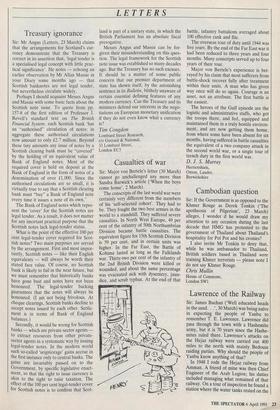Casualties of war
Sir: Major von Bertele's letter (30 March) cannot go unchallenged any more than Sandra Barwick's article ('When the boys come home', 2 March).
The conscripts of the last world war were certainly very different from the members of his 'self-selected cohort'. They had to be. They fought the two best armies in the world to a standstill. They suffered severe casualties. In North West Europe, 49 per cent of the infantry of 50th Northumbrian Division became battle casualties. The equivalent figure for 15th Scottish Division is 59 per cent, and in certain units was higher. In the Far East, the Battle of Kohima lasted as long as the Falklands war. Thirty-two per cent of the infantry of the 2nd British Division were killed or wounded, and about the same percentage was evacuated sick with dysentery, jaun- dice, and scrub typhus. At the end of that battle, infantry battalions averaged about 100 effective rank and file.
The overseas tour of duty until 1944 was five years. By the end of the Far East war it had been reduced to three years and four months. Many conscripts served up to four years of their tour.
Major von Bertele's experience is bet- rayed by his claim that most sufferers from battle-shock recover fully after treatment within their units. A man who has given way once will do so again. Courage is an asset, not an attribute. The first battle is the easiest.
The heroes of the Gulf episode are the logistic and administrative staffs, who got the troops there, and fed, equipped and maintained them in a truly hostile environ- ment, and are now getting them home, from where some have been absent for six months, having suffered in battle casualties the equivalent of a two company attack in the second world war, or a single tour of trench duty in the first world war.
D. J. S. Murray
Herriotshiels, Oxton, Lauder, Berwickshire


















































 Previous page
Previous page